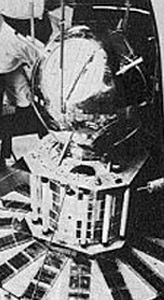Thank you very much for visiting Gunter's Space Page. I hope that this site is useful and informative for you.
If you appreciate the information provided on this site, please consider supporting my work by making a simple and secure donation via PayPal. Please help to run the website and keep everything free of charge. Thank you very much.
Injun 1
 Injun 1 [UoI] |
 Injun 1 (under Grab 2 / Solrad 3) [UoI] |
The satellite Injun 1 was the first of a series of spacecraft designed and built by the University of Iowa to study the natural and artificial trapped radiation belts, auroras and airglow, and other geophysical phenomena.
Injun 1 was launched simultaneously with Transit 4A and Solrad 3 / Grab 3. For launch, the cylindrical Injun 1 was contained in a cage-like structure between Transit 4A and Solrad 3. Transit 4A successfully separated from Injun 1, but Grab 2 (Solrad 3) did not. Injun 1 was designed to be magnetically aligned. However, due to the presence of Solrad 3 / Grab 3 (which blocked the view of the photometer), it was impossible to keep the satellite constantly oriented on the terrestrial magnetic field throughout an orbit. A single axis fluxgate magnetometer was used to monitor the orientation of the spacecraft with respect to the local magnetic field. Injun 1 had a complex spin-and-tumble motion with an ill-defined and variable period of several minutes. The satellite sent back radiation data until 6 March 1963, and is expected to be in orbit for about 900 yr.
It carried following instruments:
- Geiger-Mueller Counter
- Cadmium Sulfide Detector
- Electron Differential Energy Spectrometer
- Auroral and Airglow
- Fluxgate Magnetometer
- Solid-State Proton Detector
- 2- to 8-A and 8- to 20-A X-Ray Detectors
| Nation: | USA |
|---|---|
| Type / Application: | Research, ionosphere |
| Operator: | University of Iowa |
| Contractors: | University of Iowa |
| Equipment: | See above |
| Configuration: | |
| Propulsion: | None |
| Power: | Solar cells, batteries |
| Lifetime: | |
| Mass: | 16 kg |
| Orbit: | 882 km × 996 km, 66.82° |
| Satellite | COSPAR | Date | LS | Launch Vehicle | Remarks | |
|---|---|---|---|---|---|---|
| Injun 1 | 1961 ο 2 | 29.06.1961 | CC LC-17B | P | Thor-DM21 Able-Star | with Transit 4A, Grab 2 (Solrad 3) |
References:
- NSSDC Master Catalog: Injun 1
